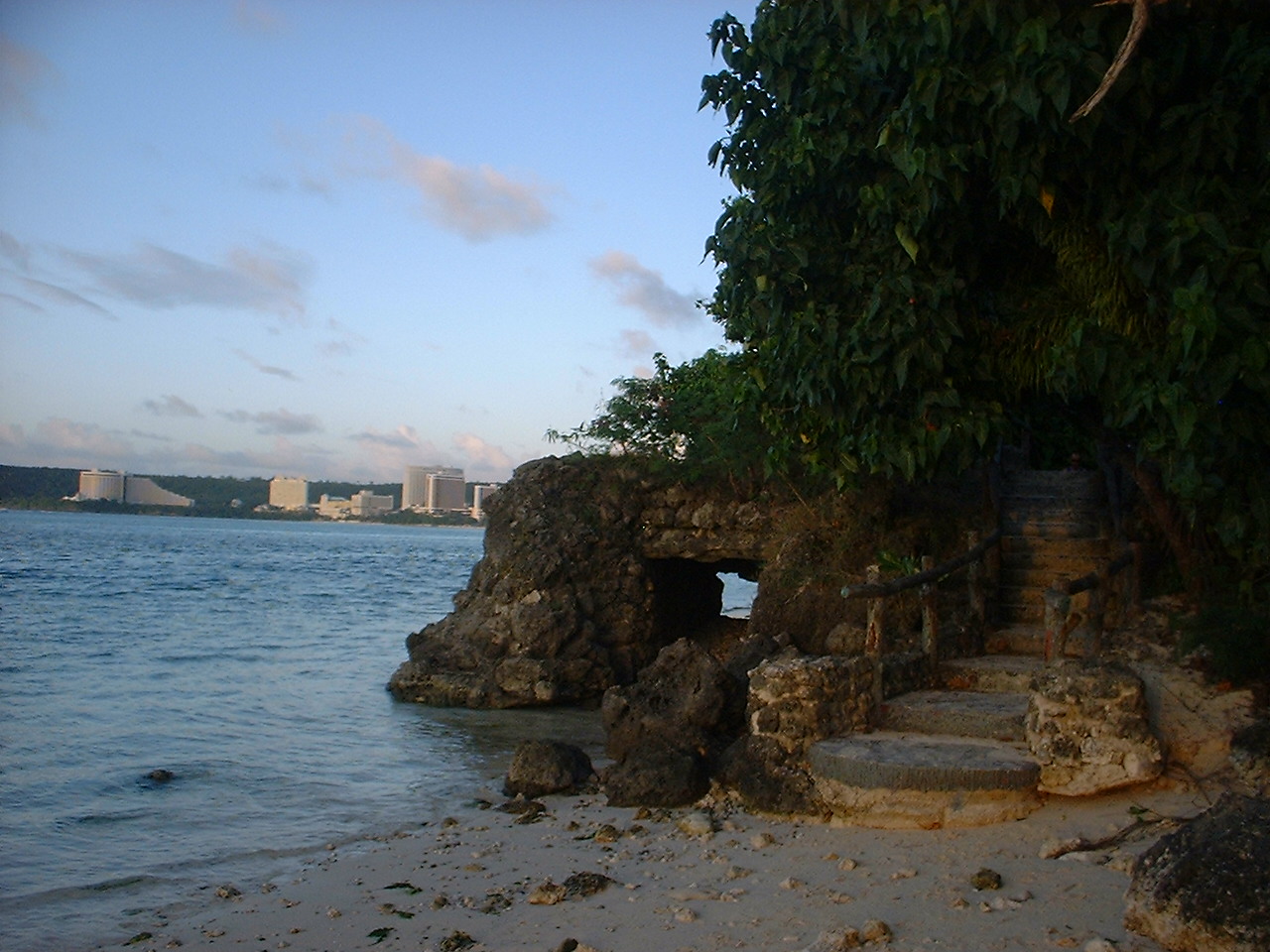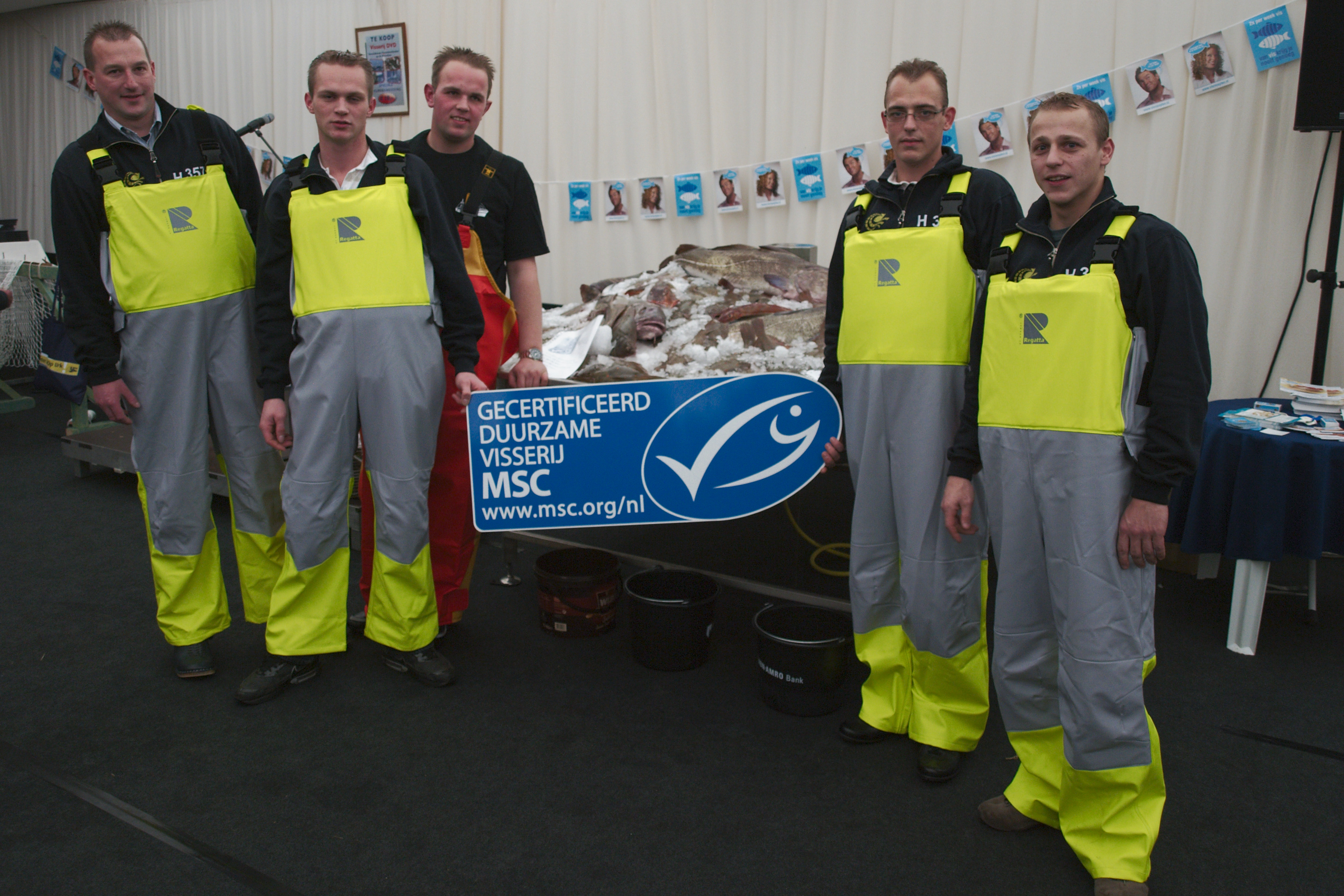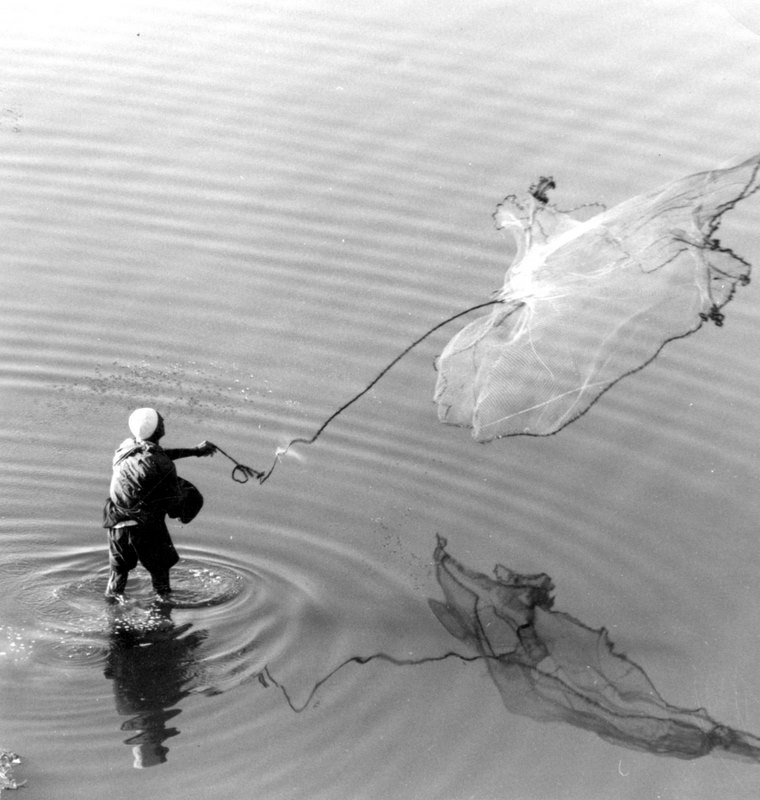|
Tumon Bay
Tumon Bay is a bay in the United States territory of Guam, opening to the Philippine Sea. It is bounded to the north by Two Lovers Point and to the south by Ypao Point. The entirety of the bay falls within the Tumon Bay Marine Preserve, also known as the Tumon Bay Marine Preserve Area (MPA) and Tumon Preserve, one of five marine preserves on Guam. The Preserve measures 4.54 square kilometers and is roughly two miles long. The platform of the fringing reef that separates the open ocean from the lagoon is up to wide. and up to one mile from the shore. The bay is located off of the Tumon area, the tourist center of the island, in the village of Tamuning. The bay is extensively utilized for recreation and fishing. History Tumon Bay or Agana Bay are the most likely locations that Ferdinand Magellan dropped anchor on March 6, 1521, which was the island's first encounter with Europeans. The bodies of Diego Luis de San Vitores and Pedro Calungsod were thrown into the bay following their ... [...More Info...] [...Related Items...] OR: [Wikipedia] [Google] [Baidu] |
Guam Division Of Aquatic And Wildlife Resources
Guam (; ch, Guåhan ) is an organized, unincorporated territory of the United States in the Micronesia subregion of the western Pacific Ocean. It is the westernmost point and territory of the United States (reckoned from the geographic center of the U.S.); its capital Hagåtña (144°45'00"E) lies further west than Melbourne, Australia (144°57'47"E). In Oceania, Guam is the largest and southernmost of the Mariana Islands and the largest island in Micronesia. Guam's capital is Hagåtña, and the most populous village is Dededo. People born on Guam are American citizens but have no vote in the United States presidential elections while residing on Guam and Guam delegates to the United States House of Representatives have no vote on the floor. Indigenous Guamanians are the Chamoru, historically known as the Chamorro, who are related to the Austronesian peoples of Indonesia, the Philippines, Malaysia, Taiwan, Micronesia, and Polynesia. As of 2022, Guam's population is 168 ... [...More Info...] [...Related Items...] OR: [Wikipedia] [Google] [Baidu] |
Guam
Guam (; ch, Guåhan ) is an organized, unincorporated territory of the United States in the Micronesia subregion of the western Pacific Ocean. It is the westernmost point and territory of the United States (reckoned from the geographic center of the U.S.); its capital Hagåtña (144°45'00"E) lies further west than Melbourne, Australia (144°57'47"E). In Oceania, Guam is the largest and southernmost of the Mariana Islands and the largest island in Micronesia. Guam's capital is Hagåtña, and the most populous village is Dededo. People born on Guam are American citizens but have no vote in the United States presidential elections while residing on Guam and Guam delegates to the United States House of Representatives have no vote on the floor. Indigenous Guamanians are the Chamoru, historically known as the Chamorro, who are related to the Austronesian peoples of Indonesia, the Philippines, Malaysia, Taiwan, Micronesia, and Polynesia. As of 2022, Guam's population is 16 ... [...More Info...] [...Related Items...] OR: [Wikipedia] [Google] [Baidu] |
Tumon, Guam
Tumon ( ch, Tomhom) is a district located on Tumon Bay along the northwest coast of the United States unincorporated territory of Guam. Located in the municipality of Tamuning, it is the center of Guam's tourist industry. History Tumon Bay or Agana Bay are the most likely locations that Ferdinand Magellan dropped anchor on March 6, 1521, though there was little further contact for the next 150 years. When the Spanish Empire colonized Guam in 1668, ''Tomhom'' was one of the most prominent villages. The first Roman Catholic missionaries to the island, the Jesuit Padre (''Pålé''), the Spanish priest Blessed Diego Luis de San Vitores and his sacristan, the Visayan Saint Pedro Calungsod were killed in Tumon by the village chief Matå'pang after San Vitores had baptised the chief's daughter without permission, but with mother's permission. This was an early inciting incident of the Spanish-Chamorro Wars. A park and statue mark the site of De San Vitores and Calungsod's martyrdom al ... [...More Info...] [...Related Items...] OR: [Wikipedia] [Google] [Baidu] |
Tumon Bay Marine Preserve Benthic Cover
Tumon ( ch, Tomhom) is a district located on Tumon Bay along the northwest coast of the United States unincorporated territory of Guam. Located in the municipality of Tamuning, it is the center of Guam's tourist industry. History Tumon Bay or Agana Bay are the most likely locations that Ferdinand Magellan dropped anchor on March 6, 1521, though there was little further contact for the next 150 years. When the Spanish Empire colonized Guam in 1668, ''Tomhom'' was one of the most prominent villages. The first Roman Catholic missionaries to the island, the Jesuit Padre (''Pålé''), the Spanish priest Blessed Diego Luis de San Vitores and his sacristan, the Visayan Saint Pedro Calungsod were killed in Tumon by the village chief Matå'pang after San Vitores had baptised the chief's daughter without permission, but with mother's permission. This was an early inciting incident of the Spanish-Chamorro Wars. A park and statue mark the site of De San Vitores and Calungsod's martyrdo ... [...More Info...] [...Related Items...] OR: [Wikipedia] [Google] [Baidu] |
Philippine Sea
The Philippine Sea is a marginal sea of the Western Pacific Ocean east of the Philippine archipelago (hence the name), the largest in the world, occupying an estimated surface area of . The Philippine Sea Plate forms the floor of the sea. Its western border is the first island chain to the west, comprising the Ryukyu Islands in the northwest and Taiwan in the west. Its southwestern border comprises the Philippine islands of Luzon, Catanduanes, Samar, Leyte, and Mindanao. Its northern border comprises the Japanese islands of Honshu, Shikoku and Kyūshū. Its eastern border is the second island chain to the east, comprising the Bonin Islands and Iwo Jima in the northeast, the Mariana Islands (including Guam, Saipan, and Tinian) in the due east, and Halmahera, Palau, Yap and Ulithi (of the Caroline Islands) in the southeast. Its southern border is Indonesia's Morotai Island. The sea has a complex and diverse undersea relief. The floor is formed into a structural ... [...More Info...] [...Related Items...] OR: [Wikipedia] [Google] [Baidu] |
Snorkeling
Snorkeling ( British and Commonwealth English spelling: snorkelling) is the practice of swimming on or through a body of water while equipped with a diving mask, a shaped breathing tube called a snorkel, and usually swimfins. In cooler waters, a wetsuit may also be worn. Use of this equipment allows the snorkeler to observe underwater attractions for extended periods with relatively little effort and to breathe while face-down at the surface. Snorkeling is a popular recreational activity, particularly at tropical resort locations. It provides the opportunity to observe underwater life in a natural setting without the complicated equipment and training required for scuba diving. It appeals to all ages because of how little effort is involved and is the basis of the two surface disciplines of the underwater sport of finswimming. Snorkeling is also used by scuba divers when on the surface, in underwater sports such as underwater hockey and underwater rugby, and as part of wa ... [...More Info...] [...Related Items...] OR: [Wikipedia] [Google] [Baidu] |
Fishing In Guam (256789457)
Fishing is the activity of trying to catch fish. Fish are often caught as wildlife from the natural environment, but may also be caught from fish stocking, stocked bodies of water such as fish pond, ponds, canals, park wetlands and reservoirs. Fishing techniques include gathering seafood by hand, hand-gathering, spearfishing, spearing, fish net, netting, angling, bowfishing, shooting and fish trap, trapping, as well as destructive fishing practices, more destructive and often illegal fishing, illegal techniques such as electrofishing, electrocution, blast fishing, blasting and cyanide fishing, poisoning. The term fishing broadly includes catching aquatic animals other than fish, such as crustaceans (shrimp/lobsters/crabs), shellfish, cephalopods (octopus/squid) and echinoderms (starfish/sea urchins). The term is not normally applied to harvesting fish raised in aquaculture, controlled cultivations (fish farming). Nor is it normally applied to hunting aquatic mammals, where term ... [...More Info...] [...Related Items...] OR: [Wikipedia] [Google] [Baidu] |
Illegal Fishing
Illegal, unreported and unregulated fishing (IUU) is an issue around the world. Fishing industry observers believe IUU occurs in most fisheries, and accounts for up to 30% of total catches in some important fisheries. Illegal fishing takes place when vessels or harvesters operate in violation of the laws of a fishery. This can apply to fisheries that are under the jurisdiction of a coastal state or to high seas fisheries regulated by regional fisheries management organisations (RFMO). According to the UN Food and Agriculture Organization (FAO), Fisheries and Aquaculture Department, illegal fishing has caused losses estimated at US$23 billion per year. Unreported fishing is fishing that has been unreported or misreported to the relevant national authority or RFMO, in contravention of applicable laws and regulations. Unregulated fishing generally refers to fishing by vessels without nationality, vessels flying the flag of a country not party to the RFMO governing that fishin ... [...More Info...] [...Related Items...] OR: [Wikipedia] [Google] [Baidu] |
Pelagic Fish
Pelagic fish live in the pelagic zone of ocean or lake waters—being neither close to the bottom nor near the shore—in contrast with demersal fish that do live on or near the bottom, and reef fish that are associated with coral reefs. The marine pelagic environment is the largest aquatic habitat on Earth, occupying 1,370 million cubic kilometres (330 million cubic miles), and is the habitat for 11% of known fish species. The oceans have a mean depth of . About 98% of the total water volume is below , and 75% is below . Moyle and Cech, p. 585 Marine pelagic fish can be divided into coastal (inshore) fish and oceanic (offshore) fish. Coastal pelagic fish inhabit the relatively shallow and sunlit waters above the continental shelf, while oceanic pelagic fish inhabit the vast and deep waters beyond the continental shelf (even though they also may swim inshore). Pelagic fish range in size from small coastal forage fish, such as herrings and sardines, to large ape ... [...More Info...] [...Related Items...] OR: [Wikipedia] [Google] [Baidu] |
Acanthurus Triostegus
''Acanthurus triostegus'', also known as the convict tang, convict surgeonfish, or manini, is a small surgeonfish in family Acanthuridae of the order Perciformes. It is typically about long, but some individuals may reach 27 cm. These tangs are widespread. They are found in the Indo-Pacific except for seas around the Arabian Peninsula, in the Pacific at the Hawaiian Islands, and in the Eastern Pacific they are found in the lower Gulf of California and down to Panama, including the Revillagigedo Islands, Clipperton Island, Cocos Island, and Galápagos Islands with some reports throughout the Mediterranean and Adriatic Sea most likely entering through the Suez Canal. Description The convict tang is so called because of its bold black stripes on a yellowish background. It is a laterally-compressed oval-shaped fish with a maximum length of about . The head is small with a pointed snout and a terminal mouth with thick lips. It has six black stripes which distinguishes it from ... [...More Info...] [...Related Items...] OR: [Wikipedia] [Google] [Baidu] |
Rabbitfish
Rabbitfishes or spinefoots are perciform fishes in the family Siganidae. The 29 species are in a single genus, ''Siganus''. In some now obsolete classifications, the species having prominent face stripes—colloquially called foxfaces–are in the genus ''Lo''. Other species, such as the masked spinefoot (''S. puellus''), show a reduced form of the stripe pattern. Rabbitfishes are native to shallow waters in the Indo-Pacific, but '' S. luridus'' and '' S. rivulatus'' have become established in the eastern Mediterranean via Lessepsian migration. They are commercially important food fish, and can be used in the preparation of dishes such as ''bagoong''. Taxonomy The Siganidae was first formally described as a family in 1837 by the Scottish naval surgeon, naturalist and arctic explorer Sir John Richardson. The genus ''Siganus'' was described in 1775 by the Danish zoologist Johan Christian Fabricius with ''Siganus rivulatus'', a species also described by Fabricius in 177 ... [...More Info...] [...Related Items...] OR: [Wikipedia] [Google] [Baidu] |
Cast Net
A casting net, also called a throw net, is a net used for fishing. It is a circular net with small weights distributed around its edge. The net is cast or thrown by hand in such a manner that it spreads out while it's in the air before it sinks into the water. This technique is called net casting or net throwing. Fish are caught as the net is hauled back in.Dunbar This simple device is particularly effective for catching small bait or forage fish, and has been in use, with various modifications, for thousands of years. __TOC__ Construction and technique Contemporary cast nets have a radius which ranges from 4 to 12 feet (1.2 to 3.6 metres). Only strong people can lift the larger nets once they are filled with fish. Standard nets for recreational fishing have a four-foot hoop. Weights are usually distributed around the edge at about one pound per foot (1.5 kilograms per metre). Attached to the net is a handline, one end of which is held in the hand as the net is thrown. Whe ... [...More Info...] [...Related Items...] OR: [Wikipedia] [Google] [Baidu] |










